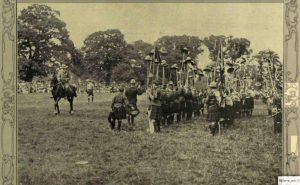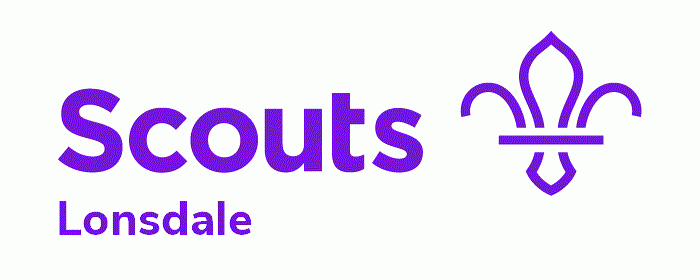July 4th, 1911
LANCASTER BOY SCOUTS
AT THE ROYAL REVIEW
Upwards of 35,000 Boy Scouts from all parts of the United Kingdom and the Colonies were inspected by his Majesty the King, in Windsor Great Park, on July 4th, 1911.
The Lancaster contingent, consisting of twenty boys and three officers, from the 1st, 2nd, 3rd, 4th and 6th troops, was under the command of Scout-master R. E. Wright (4th Lancaster) assisted by Scout-master J. R. Erskine (1st Lancaster), and Assistant S.M. E. Marks, (4th), Patrol-leader Coupland (1st) bearing the troop-flag, acted as leader in the Rally.
The detachment assembled in Dalton-square soon after 9 p.m. on Monday, 3rd inst., and after kit inspection at the Sulyard-street Schools, marched, to the strains of bugle and drum and accompanied by many of their scout comrades also in uniform, to the Castle Station, by way of Common Garden-street and King street. Joining the Kendal contingent in the, 10-7 p.m. train south, they had a most enthusiastic “send-off” by a large company of comrades and friends.
Detraining at Preston, an hour’s wait ensued till, at 11-30, they entered the special corridor train, which conveyed them direct through to Windsor.
Detachments from Carlisle, Blackburn, Clitheroe also joined the special at Preston, whilst at Warrington, Crewe, and many other stations the train stopped to pick up further contingents of scouts, whose noisy entrance with cheers and bugle-blowing completely put all possibility of sleep out of the question. Few, if any, of the boys had obtained even a “wink,” when about 7-15 on the morning of the Fourth the train drew up in Windsor Station and discharged its load of eager and wide-awake scouts, in spite of the fact that no ” freshener up ” was obtainable , owing to the supply of water for washing having given out by 4 a.m. in all the coaches.
Immediately on detraining the troops were formed up on the platform, the King’s Scouts and Life Savers being placed by themselves, apart. Boys were selected to collect kit bags and stack them. Scout-masters in command reported themselves and received their tickets showing route and place of assembly. Proceeding from the station the Lancaster Scouts, with several hundred others, marched through Windsor to the ground, where they formed up and received their orders to re-assemble at 12 noon.
Making their way to the Camp in hopes of obtaining a good breakfast, they found to their dismay that not sufficient food was obtainable nor did they fare any better when again they tried for luncheon later on; so it was a company of tired and hungry boys that met on the assembly ground at noon, and later on took up their position in Section C on the Review Ground. This section consisted of about 2,000 Scouts, including acting scoutmasters and patrol leaders.
The troops were arranged in semi-circles. The centre of the base, or diameter, was occupied by the Union Jack, and near by was the Royal Standard (hoisted on the King’s arrival). Occupying the first, or innermost, semi-circle, on each side of the platform and band stand, were the King’s Scouts, and behind these the Life-savers and the Colonial Flag bearers. Amongst the King’s Scouts, Lancaster was represented by Patrol-leader H. Dobson of the 4th, who also had the honour of being selected to be a “Colonial Flag bearer,” the flag allotted to him being that of North Borneo. The position of the Lancasters was in the outermost semi-circle, and behind them was a line of unattached officers.
Soon after 2, the Chief Scout (Sir R. Baden-Powell) rode round the sections, and was everywhere greeted with tremendous cheers Then came another long wait till 3 p.m., when the King arrived.
After a long and sleepless night-journey, and little or no food, followed by the protracted inaction, there is little wonder that some few of the 35,000 thousand boys (many of them under 14) became faint and had to be carried off by the ambulance. Of these upwards of 20 succumbed nearby the Lancaster contingent one of them belonging to the itself.
At one period of waiting, so quickly did the faintings occur, that no less than eight were carried away in ten minutes.
About 3-30 the Royal procession commenced its journey round the sections. First came the soldiers and the Indian Marajahs, etc., then the King, accompanied by the Chief Scout, and followed by more officers. After them, in her carriage, rode Queen Mary, with Princess May and the Prince of Wales.
Most of the Lancaster boys were fortunate in getting a full-faced view of their King, and to their great satisfaction the Queen also had her face turned their way as she rode past.
After the inspection came the Rally, the Scout songs, and finally the “hat-on-stave” cheer; then dismissal.
Suitable food not being obtainable in Camp, the town of Windsor was raided for supplies. But there also, bread was so scarce that loaves had to be obtained from private houses for Boy Scout consumption. Someone had seriously bungled the Camp catering.
Satisfactory meals, however, were obtained in Windsor, and the Lancasters, refreshed and strengthened, returned to camp, where they spent the night.
Returning to London by “special” on Wednesday, the few hours at their disposal were spent in dinner, buying presents, and sight-seeing, including, of course, the Zoo.
Entering their corridor-coach at 4-10 p m. from Euston, the fortunate Lancaster Scouts, who had enjoyed to the full their privilege of being present at the King’s Review, arrived safely home soon after 10 p.m.
From Log Book kept by R.E. Wright, 4th Lancaster


